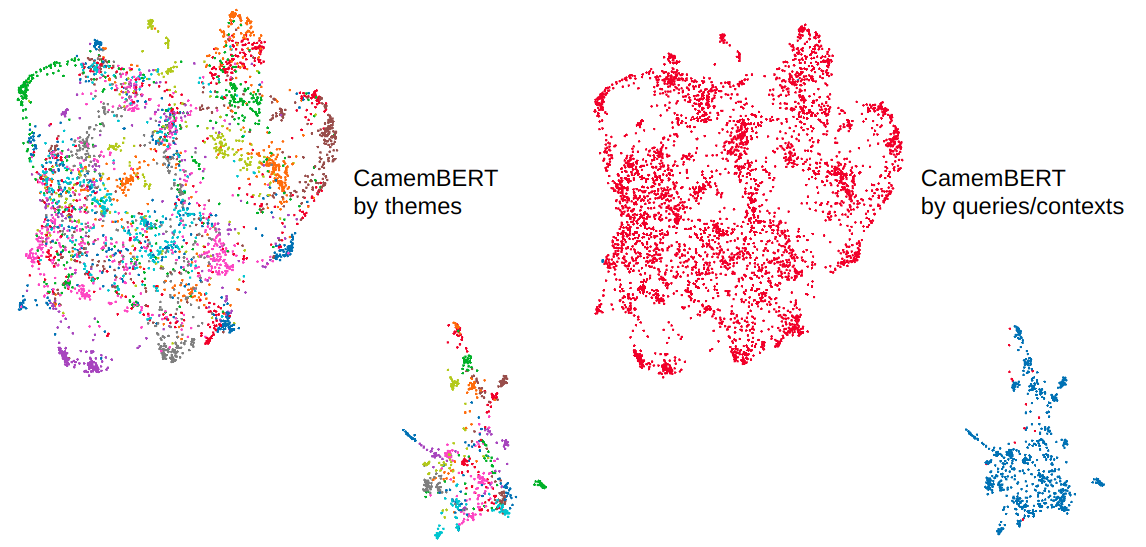|
--- |
|
license: bigscience-bloom-rail-1.0 |
|
language: |
|
- fr |
|
- en |
|
pipeline_tag: feature-extraction |
|
--- |
|
|
|
# Note |
|
|
|
|
|
We now strongly recommend using the [Bloomz-560m-retriever-v2](https://huggingface.co/cmarkea/bloomz-560m-retriever-v2) model, **which offers significantly superior performance**. |
|
|
|
Bloomz-560m-retriever |
|
--------------------- |
|
|
|
We introduce the Bloomz-560m-retriever based on the [Bloomz-560m-sft-chat](https://huggingface.co/cmarkea/bloomz-560m-sft-chat) model. This model enables the creation of an embedding representation of text and queries for a retrieval task, linking queries to documents. The model is designed to be cross-language, meaning it is language-agnostic (English/French). This model is ideal for Open Domain Question Answering (ODQA), projecting queries and text with an algebraic structure to bring them closer together. |
|
|
|
 |
|
|
|
Training |
|
-------- |
|
|
|
It is a bi-encoder trained on a corpus of context/query pairs, with 50% in English and 50% in French. The language distribution for queries and contexts is evenly split (1/4 French-French, 1/4 French-English, 1/4 English-French, 1/4 English-English). The learning objective is to bring the embedding representation of queries and associated contexts closer using a contrastive method. The loss function is defined in [Deep Metric Learning using Triplet Network](https://arxiv.org/abs/1412.6622). |
|
|
|
Benchmark |
|
--------- |
|
|
|
Based on the SQuAD evaluation dataset (comprising 6000 queries distributed over 1200 contexts grouped into 35 themes), we compare the performance in terms of the average top contexter value for a query (Top-mean), the standard deviation of the average top (Top-std), and the percentage of correct queries within the top-1, top-5, and top-10. We compare the model with a TF-IDF trained on the SQuAD train sub-dataset (we want a fixed algebraic structure for the vector database instead of a variable structure every time we add a new document, then the IDF part has frozen), CamemBERT, Sentence-BERT, and finally our model. We observe these performances in both monolingual and cross-language contexts (query in French and context in English). |
|
|
|
Model (FR/FR) | Top-mean | Top-std | Top-1 (%) | Top-5 (%) | Top-10 (%) | |
|
|----------------------------------------------------------------------------------------------------:|:--------:|:-------:|:---------:|:---------:|:----------:| |
|
| TF-IDF | 128 | 269 | 23 | 46 | 56 | |
|
| [CamemBERT](https://huggingface.co/camembert/camembert-base) | 417 | 347 | 1 | 2 | 3 | |
|
| [Sentence-BERT](https://huggingface.co/sentence-transformers/paraphrase-multilingual-mpnet-base-v2) | 11 | 41 | 43 | 71 | 82 | |
|
| [Bloomz-560m-retriever](https://huggingface.co/cmarkea/bloomz-560m-retriever) | 10 | 47 | 51 | 78 | 86 | |
|
| [Bloomz-3b-retriever](https://huggingface.co/cmarkea/bloomz-3b-retriever) | 9 | 37 | 50 | 79 | 87 | |
|
|
|
Model (EN/FR) | Top-mean | Top-std | Top-1 (%) | Top-5 (%) | Top-10 (%) | |
|
|----------------------------------------------------------------------------------------------------:|:--------:|:-------:|:---------:|:---------:|:----------:| |
|
| TF-IDF | 607 | 334 | 0 | 0 | 0 | |
|
| [CamemBERT](https://huggingface.co/camembert/camembert-base) | 432 | 345 | 0 | 1 | 1 | |
|
| [Sentence-BERT](https://huggingface.co/sentence-transformers/paraphrase-multilingual-mpnet-base-v2) | 12 | 47 | 44 | 73 | 83 | |
|
| [Bloomz-560m-retriever](https://huggingface.co/cmarkea/bloomz-560m-retriever) | 10 | 44 | 49 | 77 | 86 | |
|
| [Bloomz-3b-retriever](https://huggingface.co/cmarkea/bloomz-3b-retriever) | 9 | 38 | 50 | 78 | 87 | |
|
|
|
We observed that TF-IDF loses robustness in cross-language scenarios (even showing lower performance than CamemBERT, which is a model specialized in French). This can be explained by the fact that a Bag-Of-Words method cannot support this type of issue because, for a given sentence between two languages, the embedding vectors will be significantly different. |
|
|
|
CamemBERT exhibits poor performance, not because it poorly groups contexts and queries by themes, but because a meta-cluster appears, separating contexts and queries (as illustrated in the image below), making this type of modeling inappropriate in a retriever context. |
|
|
|
 |
|
|
|
How to Use Bloomz-560m-retriever |
|
-------------------------------- |
|
|
|
The following example utilizes the API Pipeline of the Transformers library. |
|
|
|
```python |
|
import numpy as np |
|
from transformers import pipeline |
|
from scipy.spatial.distance import cdist |
|
|
|
retriever = pipeline('feature-extraction', 'cmarkea/bloomz-560m-retriever') |
|
|
|
# Inportant: take only last token! |
|
infer = lambda x: [ii[0][-1] for ii in retriever(x)] |
|
|
|
list_of_contexts = [...] |
|
emb_contexts = np.concatenate(infer(list_of_contexts), axis=0) |
|
list_of_queries = [...] |
|
emb_queries = np.concatenate(infer(list_of_queries), axis=0) |
|
|
|
# Important: take l2 distance! |
|
dist = cdist(emb_queries, emb_contexts, 'euclidean') |
|
top_k = lambda x: [ |
|
[list_of_contexts[qq] for qq in ii] |
|
for ii in dist.argsort(axis=-1)[:,:x] |
|
] |
|
|
|
# top 5 nearest contexts for each queries |
|
top_contexts = top_k(5) |
|
``` |
|
|
|
Citation |
|
-------- |
|
|
|
```bibtex |
|
@online{DeBloomzRet, |
|
AUTHOR = {Cyrile Delestre}, |
|
ORGANIZATION = {Cr{\'e}dit Mutuel Ark{\'e}a}, |
|
URL = {https://huggingface.co/cmarkea/bloomz-560m-retriever}, |
|
YEAR = {2023}, |
|
KEYWORDS = {NLP ; Transformers ; LLM ; Bloomz}, |
|
} |
|
``` |